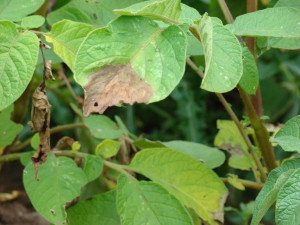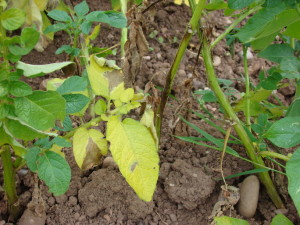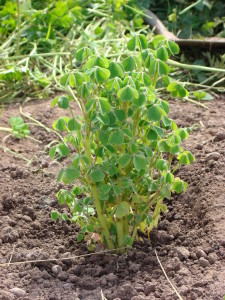Potato blight is a fungal disease that can affect potatoes and tomato plants. It blows in on the wind which means that even an uninfected plot can become infected. Once you get the blight it will stay in the soil for years and is very difficult to get rid of. It thrives in damp conditions and you can help prevent blight by watering your potatoes at the base of the plant rather than on the leaves.
The following video will give you some tips and advice on how to combat the blight.
https://www.youtube.com/watch?v=t9jPsi-v0eI
Potato blight can be spotted by the leaves of your plants by brown spots and the leaves starting to go curl up.
The picture above shows you potato blight affecting leaves. The stems will also turn brown and eventually the whole plant will start to die back.
When you find potato blight on your plants you need to remove any infected leaves. These must not be composted and needs to be removed from your growing site and destroyed. Composting them will put the blight fungus in your compost which you will then spread all over the ground when you use it.
Once the blight has really taken hold then you need to cut the foliage off your plants, i.e. cut them down to ground level. This will stop the infection from spreading. Again, this foliage needs removing and destroying. Keep watering your potatoes, particularly when it is dry, as they will swell up some more even like this.
You can leave the potatoes in the ground for some weeks, harvesting them as you need them, though if the weather becomes particularly wet you need to lift them all and store them so they do not rot. I lifted all of my potatoes because there was quite a lot of slug and wire worm damage which I was worried would damage a lot of the crop.
Potato blight is very hard to protect yourself against but there are sprays you can use on your potato leaves but this just seems to delay the blight taking hold rather than prevent it completely. You can buy blight resistant varieties of potatoes. The blight resistant variety I planted seems to have resisted the blight long enough to flower and mature though the plants are now starting to become infected.
Potato blight is a major problem for many growers and if you plant your potatoes early and take the steps above then you can get it under control. Once you have the blight then you can use blight resistant varieties of potatoes which will hopefully resist the blight long enough for the potatoes to mature.


























